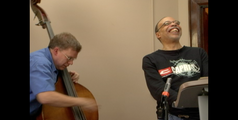Musical Archetypes and Collective Consciousness: Cognitive Distribution and Free Improvisation
Jared B. Burrows
Published: 2004-09-01
This paper investigates free improvisation from the perspectives offered by cognitive distribution theories as pioneered by Vygotsky, Wundt, and Mead. Using a hypothetical 'script' of an improvised performance, the paper suggests possible explanations for the kinds of socially-mediated, cognitive interactions which can take place in a group improvisation. Diagrams and models developed from Engeström's work on activity theory are used as heuristic devices to explore the possible physical and psychological conditions and factors which influence and contribute to a group performance. Successive models are shown to be useful in understanding certain aspects of the improvising process, but it is also made clear that there are key spiritual and emotional components of the process which defy empirical observation and description. The paper suggests that improvised musical dialogue and narrative are developed through 'archetypes', musical gestures which carry meanings and intentions between and among participants in a performance.
Available Files
-
Musical_Archetypes.pdf
Download


